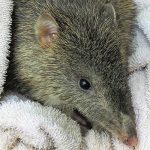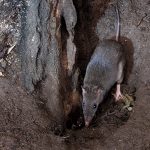LONG-NOSED BANDICOOT
The Long-nosed Bandicoot: Nature’s Little Night Gardener
In the soft hush of an Australian night, a small shadow moves through the undergrowth. Its pointed snout twitches, catching the scent of earthworms beneath the soil. This is the Long-nosed bandicoot — a quiet, nocturnal gardener of our ecosystems, whose life is as fascinating as it is important.
Appearance and Adaptations
The Long-nosed bandicoot is a small marsupial with a distinctive, pointed snout that gives it its name. Its sleek, streamlined body is covered in coarse, greyish-brown fur, with a paler underbelly that blends into the soft light of moonlit nights.
- Tail: Short and rounded, unlike many of its marsupial relatives.
- Legs: Strong hind legs give it a hopping gait, though it can also scurry quickly when needed.
- Claws: Sharp and sturdy, perfect for digging into soil in search of food.
Habitat: From Rainforests to Backyards
These adaptable creatures are found along eastern Australia, from the warm coasts of Queensland down to the cooler regions of Victoria. They thrive in:
- Rainforests and wet sclerophyll forests
- Woodlands with dense undergrowth
- Urban gardens and parks, where food and shelter are available
Their ability to live alongside humans means it’s not unusual to see one emerging from a suburban garden bed under the cover of darkness.
Diet: Nature’s Soil Aerators
As omnivores, Long-nosed bandicoots enjoy a varied menu:
- Animal food: Insects, spiders, earthworms, and other invertebrates
- Plant matter: Seeds, roots, tubers, and fungi
When they dig for their meals, they turn and aerate the soil, helping plants grow and assisting in seed dispersal — a vital ecological service often overlooked.
Behaviour and Life Cycle
- Nocturnal: Active mainly at night, foraging with the help of a keen sense of smell.
- Solitary: Generally live alone, coming together only to mate.
- Breeding: Can occur year-round. Females may have up to four litters a year.
- Gestation: Surprisingly short — about 12 days, one of the shortest of any mammal.
- Pouch life: Joeys remain in their mother’s pouch for roughly 50 days before exploring outside.
- Lifespan: Usually 2–3 years in the wild, though this can vary depending on predators and environmental conditions.
Communication
They are not particularly vocal, but can make grunts or snuffling sounds when foraging. If startled or threatened, they may emit a sharp, high-pitched squeal — a warning to potential predators.
Conservation Status and Threats
Currently classified as Least Concern by the IUCN, the Long-nosed bandicoot still faces challenges:
- Habitat loss from land clearing and urban development
- Predation by introduced species such as foxes, cats, and dogs
- Vehicle collisions when crossing roads at night
Subtle conservation note: Protecting native vegetation, keeping domestic pets indoors at night, and driving carefully in known wildlife areas can all help safeguard these small but essential marsupials.
Why They Matter
Think of the Long-nosed bandicoot as a natural gardener, tilling the soil and planting seeds without even knowing it. Every scratch of their claws contributes to a healthier, more balanced environment.
By understanding and appreciating animals like the Long-nosed bandicoot, we’re reminded that even the smallest creatures can have a big impact on the health of our land.
Quick Facts at a Glance
| Feature | Detail |
|---|---|
| Scientific name | Perameles nasuta |
| Size | Body length 28–43 cm; tail 7–12 cm |
| Weight | 0.5–1.5 kg |
| Lifespan | 2–3 years (wild) |
| Habitat range | Eastern Australia: QLD to VIC |
| Diet | Omnivorous – invertebrates, seeds, roots |
| Conservation status | Least Concern |



